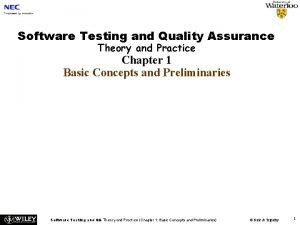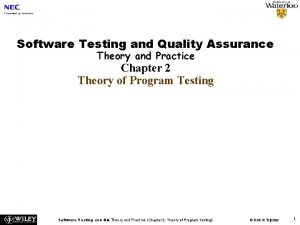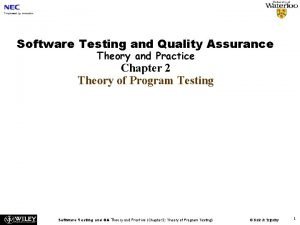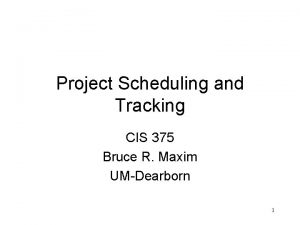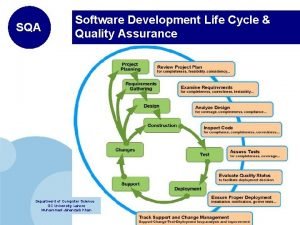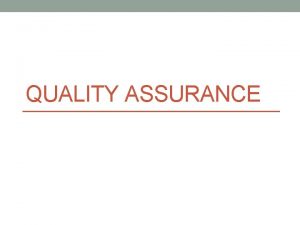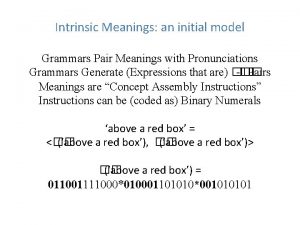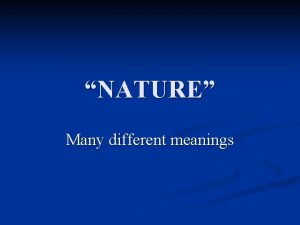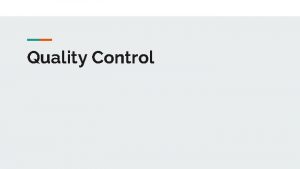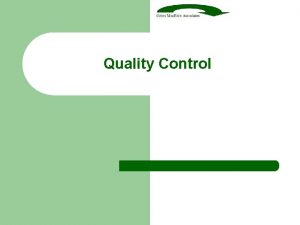Quality Control and Quality Assurance Common Meanings of
















- Slides: 16

Quality Control and Quality Assurance

Common Meanings of Quality • Quality is fitness for use • Quality is meeting customers expectations • Quality is exceeding the customers expectations • Quality is superiority to competitors

Quality Assurance (QA) - Is all those planned and systematic actions necessary to provide adequate confidence that an entity will fulfill requirements for quality.

• Quality assurance is a process based approach whose prime objective is to prevent defects in deliverables in the planning process itself to avoid the rework, which costs a lot. • Quality assurance is a proactive process, and it starts at the very beginning of the project to understand the product’s stated and non-stated requirements and expectations, and then develop the plan to meet these requirements and expectations. • Quality audit is an example of a quality assurance process. Other examples of quality assurance are training, process definition, selection of tools, etc.

The Difference between Quality Assurance and Quality Control QA QC • On the other hand in quality control, you try to find defects and correct them while making the product. Quality assurance is all about prevention. • Quality control is all about the detection. • Quality assurance is a process based approach. • Quality control is a product based approach. • Quality assurance involves processes managing quality. • Quality control is used to verify the quality of the product. • In quality assurance, you plan to avoid the defect in the first place. •

The Difference between Quality Assurance and Quality Control QC QA • Quality audit is an example of quality assurance. • The goal of the quality assurance process is to develop a process so that defects do not arise when you are producing the product • Inspection and testing are examples of the quality control process. • Quality control identifies the defects after the product is produced but is not yet released or is still in the production phase.

The Benefits of Quality Assurance and Quality Control • It gives you a high quality output. • It increases the efficiency of operations. • It brings customer satisfaction, which affects your brand helps you grow your business. • If your product is of good quality, you will not need much rework and there will not be much after-sale support required. This will help you save a lot of money. • A high level of confidence and a motivated team.

Quality Begins with Quality Design

Quality Design - It means the intentions of the designers to include/ exclude features in a product or service i. e. the degree to which the quality characteristics are embedded into the product/ service.

Total Quality Management (TQM) - Encompasses elements that form the basis of a company wide focus on quality- elements that extend from the office to the field.

Elements of Total Quality Management in Construction Process MANAGEMENT COMMITMENT & LEADERSHIP TEAMWORK TRAINING STATISTICAL METHODS TOTAL QUALITY MANAGEMENT CUSTOMER SERVICE SUPPLIER INVOLVEMENT COST OF QUALITY CONSTRUCTION INDUSTRYSPECIFIC FACTORS

• Management Commitment & Leadership - TQM is a culture and philosophy that must permeate an organization as the method of management. It can thrive only under a senior management that establishes TQM as a top priority. This commitment must be coupled with a thorough understanding of TQM. Only if supported by this commitment and understanding, can senior management lead the company toward the realization of higher quality in its undertakings. • Training - There should be customized training plans for management, engineers, technicians, home and field office staff, support personnel and field labor. • Teamwork - TQM concept to the parties mentioned above in the form of joint teams achieves higher customer satisfaction. These joint teams are responsible for establishing joint goals, plans, and controls. • Statistical Method - provide problem-solving tools to the TQM process.

• Cost of Quality - the primary tool for measuring quality. (Crosby, P. B. , Cutting the Cost of Quality. Farnsworth, Boston, 1967. ; Juran, J. M. (Ed. ), Juran's Quality Control Handbook, 4 th edn. Mc. Graw-Hill, New York, 1988. ) • Supplier Involvement - The ability to produce a quality product largely depends on the relationship among the parties involved in the process; the supplier, the processor, and the customer. • Customer Service - Customers may be either internal or external. Satisfying the needs of these customers is an essential part of the process of supplying the final external customer with a quality product. • Construction Industry- Specific Factors 1. Quality of codes and standards - According to the ASCE manual, 2 the primary purpose of codes and standards is to protect the public's health and safety. 2. Quality of drawings and specifications- Drawings and specifications are the two sets of documents given to the constructor that provide technical information on materials, performance of the constructed facility, and quality requirements. 3. Constructability of design-the design professional must consider the requirements of the constructor. The project must be constructible by those retained to build the project.

Benchmarking - Is the procedure where a company seeks out and studies the best practices in order to produce a superior performance.

Forms of Benchmarking • Internal Benchmarking- investigates the practices and performance within the company. • External Benchmarking- compares the company’s practices and performance with world-class performers.

• External Competitive Benchmarking- is comparison of company’s activity with direct competitors • External Industrial or Functional Benchmarkingcompares company’s functions with functions of other companies. • External Generic Benchmarking- broadens fields of application of benchmarking process beyond the limits of specific company and industry it belongs to.
 Quality assurance vs quality control
Quality assurance vs quality control Quality assurance vs quality control
Quality assurance vs quality control Pmp quality management
Pmp quality management Pmbok quality management
Pmbok quality management Ana model of quality assurance
Ana model of quality assurance Quality improvement vs quality assurance
Quality improvement vs quality assurance Common symbols used in literature
Common symbols used in literature Symbols in literature
Symbols in literature Quality assurance theory
Quality assurance theory Quality revolution
Quality revolution Theory of goodenough and gerhart
Theory of goodenough and gerhart Software testing and quality assurance theory and practice
Software testing and quality assurance theory and practice Quality assurance theory
Quality assurance theory Software quality assurance tools and techniques
Software quality assurance tools and techniques European standards and guidelines for quality assurance
European standards and guidelines for quality assurance Project scheduling and tracking software quality assurance
Project scheduling and tracking software quality assurance Sdlc quality assurance
Sdlc quality assurance









